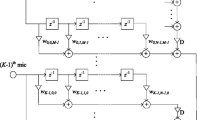Abstract
In this paper, the performance loss caused by the aperture fill phenomena and heavy computational burden in broadband adaptive beamforming (ADBF) is analyzed, and an efficient approach based on frequency–space cascade processing is presented. First, a digital compensation method is applied to compensate for the aperture fill time of the broadband phased array in the range-frequency domain, removing the dependence of the wideband array steering vector on the instantaneous frequency. Second, a subband adaptive beamforming scheme using range-compressed data is implemented, reducing the degrees of freedom of wideband jamming and avoiding signal cancelation in the ADBF covariance matrix estimation. Moreover, the conjugate gradient algorithm is used to iteratively calculate the ADBF weight vector to reduce the computational complexity. Finally, wideband ADBF can be achieved by subband synthesis. Theoretical analysis and simulation results are provided to demonstrate that the proposed approach can suppress jamming sufficiently with a rapid convergence rate, making this approach feasible for engineering implementation.








Similar content being viewed by others
References
Y. Cao, Y. Wang, S. Wang, S. Zhou, Wideband subarray beamforming based on subband decomposition, in Proceedings of the IEEE China Summit & International Conference on Signal and Information Processing (ChinaSIP) (2014), pp. 247–251
S.C. Chan, H.H. Chen, Uniform concentric circular arrays with frequency-invariant characteristics-theory, design, adaptive beamforming and DOA estimation. IEEE Trans. Signal Process. 55(1), 165–177 (2007)
H. Chen, W. Ser, Design of robust broadband beamformers with passband shaping characteristics using Tikhonov regularization. IEEE Trans. Audio Speech Lang. Process 17(4), 665–681 (2009)
Z. Chen, H. Li, M. Rangaswamy, Conjugate gradient adaptive matched filter. IEEE Trans. Aerosp. Electron. Syst. 51(1), 178–191 (2015)
M. Crocco, A. Trucco, A computationally efficient procedure for the design of robust broadband beamformers. IEEE Trans. Signal Process. 58(10), 5420–5424 (2010)
M. Crocco, A. Trucco, Design of robust super directive arrays with a tunable tradeoff between directivity and frequency-invariance. IEEE Trans. Signal Process. 59(5), 2169–2181 (2011)
O.L. Frost, An algorithm for linearly constrained adaptive array processing. Proc. IEEE 60(8), 926–935 (1972)
L. Griffiths, C.W. Jim, An alternative approach to linearly constrained adaptive beamforming. IEEE Trans. Antenna Propag. 30(1), 27–34 (1982)
B. Himed, K. Kim, Y. Zhang, A new approach to wideband space–time adaptive processing (W-STAP), in Proceedings of the IEEE Sensor Array and Multichannel Signal Processing Workshop (2004), pp. 672–676
Z. Hong, Z. Mingbo, C. Yulin, H. Xiaotao, Z. Zhimin, Performance analysis of subband stap for UWB SAR sparse array, in Proceedings of the IET International Radar Conference (2009), pp. 1–5
I.P. Kirsteins, H. Ge, Performance analysis of Krylov space adaptive beamformers, in Proceedings of the Fourth IEEE Workshop on Sensor Array and Multichannel Processing (SAM) (2006), pp. 16–20
W. Liu, S. Weiss, Wideband Beamforming: Concepts and Techniqeus (Wiley, Chichester, 2010)
S.U. Pillai, K.Y. Li, J.R. Guerci, Effect of bandwidth on wideband-STAP performance, in Proceedings of Conference on Signals, Systems and Computers (2007), pp. 2195–2198
A.O. Steinhardt, N.B. Pulsone, Subband STAP processing, the fifth generation, in Proceedings of the IEEE Sensor Array and Multichannel Signal Processing Workshop (2000), pp. 1–6
F.W. Vook, R.T. Compton, Bandwidth performance of linear adaptive arrays with tapped delay-line processing. IEEE Trans. Aerosp. Electron. Syst. 28(3), 901–908 (1992)
P.G. Vouras, T.D. Tran, Robust transmit nulling in wideband arrays. IEEE Trans. Signal Process. 62(14), 3706–3719 (2014)
Y. Yao, X. Huang, G. Wu, K. Wei, Joint equalization and fractional delay filter design for wideband digital beamforming, in Proceedings of the IEEE Radar Conference (2015), pp. 0823–0827
Y. Zhao, W. Liu, R.J. Langley, Subband design of fixed wideband beamformers based on the least squares approach. Signal Process. 91(4), 1060–1065 (2011)
Acknowledgements
This work was supported in part by the National Natural Science Foundation of China (No. 61201459, No. 61301212), Science and Technology on Electronic Information Control Laboratory and China Scholarship Council (No. 201606715009).
Author information
Authors and Affiliations
Corresponding author
Rights and permissions
About this article
Cite this article
Hu, P., Shen, M., Liang, C. et al. An Efficient Broadband Adaptive Beamforming Algorithm Based on Frequency–Space Cascade Processing. Circuits Syst Signal Process 37, 432–443 (2018). https://doi.org/10.1007/s00034-017-0545-2
Received:
Revised:
Accepted:
Published:
Issue Date:
DOI: https://doi.org/10.1007/s00034-017-0545-2




